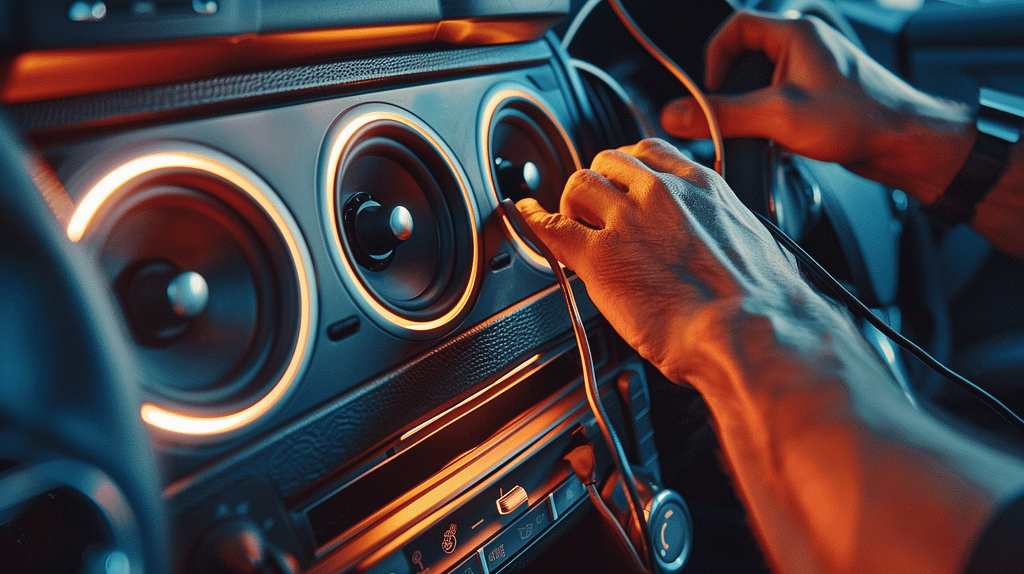Revive your car’s sound system like new by evaluating speaker damage, meticulously repairing parts, and addressing unrepairable components. Guarantee compatibility and precision in part replacements, considering universal options for different models.
Maintenance is key; clean regularly to prevent dust buildup, use gentle methods, and inspect connections consistently. For peak performance, professional advice on replacements can help preserve your system’s quality. Follow these expert strategies to enhance your car’s audio experience and keep it sounding its best.
Speaker Damage Identification
In diagnosing speaker damage, a meticulous assessment of physical integrity, sound output quality, and internal components is crucial for identifying potential issues affecting the sound system’s performance. Start by inspecting the speaker cone for tears or holes, which can greatly impact sound quality.
Conduct sound testing to listen for any distortion or absence of sound, indicating speaker damage. Additionally, check for rust accumulation on the speaker parts, as this can impede functionality. If rust is present, consider rust removal techniques to improve performance.
Also, ensure the wire connectors are intact and repair any damaged connectors promptly. Thorough examination of these aspects will help pinpoint the root cause of speaker damage, guiding the repair process effectively.
Read Also: Fix My Speaker – Remove Water from Speakers in 1 min 14 sec
Speaker Parts Repair
Efficient speaker parts repair involves meticulous inspection, targeted maintenance, and precise replacement strategies to restore peak sound quality in your car’s sound system. When repairing speaker parts, guarantee component compatibility by selecting replacements suitable for the specific speaker type.
Sourcing replacements should involve measuring the speaker size accurately before purchasing new parts. Universal speaker parts are often a good choice for various speaker models. When handling broken speaker wire connectors, make holes in the cone, solder the wires, and use new connectors for proper functionality.
Dealing With Unrepairable Parts
When encountering irreparable speaker parts, it is important to assess the necessity of replacement options to maintain the peak functionality of your car’s sound system.
Replacement options should be considered for components like tweeters that may be unrepairable. It is advisable to purchase new tweeters instead of attempting repairs to guarantee top-notch sound quality.
Seek professional advice to confirm compatibility with the existing speaker system and to select quality components for peak sound output.
Understanding the limitations of unrepairable parts and making informed decisions regarding replacements is vital in preserving the overall performance of the sound system.
Make informed choices based on expert recommendations to enhance the audio experience in your vehicle.
Maintenance and Cleaning
Regularly cleaning speaker parts is essential in preventing dust and debris buildup that can impact the performance of your car’s sound system.
To maintain your speakers effectively, consider the following speaker maintenance tips and cleaning techniques. Utilize an air blower to remove dirt and debris without causing damage to delicate components. Avoid abrasive cleaners that could harm the speaker parts. Check and clean speaker terminals regularly to guarantee a secure connection.
Frequently Asked Questions
Can I Use Household Items to Clean Speaker Parts?
While DIY cleaning for speaker parts using household items may seem convenient, it’s best to avoid them. Opt for speaker-specific cleaning products to guarantee proper maintenance and longevity. Using improper cleaners may damage delicate speaker components.
How Can I Prevent Speaker Wire Corrosion?
Preventing oxidation in speaker wire involves regular maintenance and care. Utilize corrosion prevention techniques such as cleaning with appropriate tools, ensuring secure connections, and avoiding moisture exposure. Implementing a wire care routine enhances longevity and sound quality.
Is It Necessary to Replace All Damaged Parts at Once?
Partial replacement can be a cost-effective solution for speaker repairs. Gradual repairs allow long-term maintenance. Replace only damaged parts to save on costs while ensuring peak performance. Consult with professionals for guidance on strategic replacements.
Can I Upgrade My Speakers During the Repair Process?
While it may be tempting to upgrade speakers during repair, confirm compatibility and consider installation processes. Upgrading can enhance sound quality and performance. Professional advice on speaker selection and installation is recommended for best results.
What Should I Do if the Repaired Speaker Still Sounds Distorted?
In troubleshooting distorted sound post repair, recalibrate speaker adjustments for best sound quality. Check for loose connections or misaligned components. Perform sound tests across various frequencies. Seek expert advice to diagnose and rectify persistent issues.
Conclusion
In summary, maintaining and repairing your car’s sound system is essential for peak performance and a satisfying driving experience.
One interesting statistic to keep in mind is that studies have shown that regular maintenance of car speakers can extend their lifespan by up to 50%, saving you money on costly replacements in the long run.
By following the expert advice provided in this guide, you can make sure that your car’s sound system remains in top condition, delivering high-quality audio for years to come.



